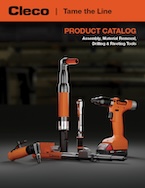Smart Factory, Industrial Internet of Things, Industry 4.0; these are buzzwords heard daily, but what’s the difference? What does it take for a factory to become smart? Can your assembly line be Industry 4.0?
These terms are closely related and are often used interchangeably, but there are some key differences. Industry 4.0 is an approach to manufacturing that involves the implementation of several different technologies which can include; industrial internet of things, cloud computing, artificial intelligence, and many others. Having these systems connected, monitoring, and communicating with one another while being able to make decisions with little or no human involvement is the foundation for becoming a Smart Factory. DC electric assembly tools are an important component to achieving this.
This vision was recently executed at a recreational vehicle manufacturer who was looking to do just that; modernize their operation while preparing themselves for future growth. A line walk revealed that the greatest initial impact could be had by replacing their pneumatic tools and handheld click wrenches with corded electric tools. Their biggest problems were having an operator either picking up an incorrect tool, or forgetting the second step altogether; using the handheld click wrench. Our NeoTek tools were programmed to use multi-stage tightening strategies allowing the operator to use only a single tool for multiple applications with varying torque targets. Additionally, the Hybrid controller is able to detect cross-threaded joints as well as an operator performing a “double-hit” on a fastener. The operator was alerted by several different methods; bright on-the-tool LEDs, handle vibration, and/or an audible alert. The operators appreciated the increased awareness of the job conditions. They were able to produce more parts in a shift by having the number of scrapped and reworked parts decrease.
On an application securing the cover plate to the rear differential it was critical that the operators followed a specific tightening pattern to ensure proper seating and to prevent leaking. The pressures of production and having to switch between tools made training and paper instructions less than effective. Product had reached the end user and warranty returns resulted from leaks that surfaced after a few hours of usage. To address this problem a feature on the Hybrid controller called Image Visualization was used. After taking a picture with their cell phone, the picture was uploaded to controller, and the operator could then be guided through the process by image markers that changed color to indicate which fastener was next, as well as if the rundown had passed or failed. This streamlined their process and reduced the time required to bring new associates up to speed.
To further reduce in-station scrap and off-line rework the operators were limited in the number of attempts to back off and re-tighten the fastener. When the number of retries had been achieved, the controller would disable the tool and the ArcNet light-stack would illuminate blue, as well as the matching LED on the tool, indicating to the line supervisor that there was an issue. The supervisor now had the opportunity to assess the situation and production could only resume after a key was used to reinitialize the system.
Shortly after installing the systems they began to encounter an unusually large amount of bad rundowns. The archived data from the previous night pinpointed the station experiencing the highest number of issues. When this data was compared to data from a month prior, there had been a 65% increased failure rate. Examining the torque traces captured by the controller showed that historically, the amount of prevailing torque observed during the free thread part of the rundown was minimal, less than 1Nm. That value had now increased to 5Nm and was, at times, reaching final torque well before the low angle limit. Examining the torque traces led the quality team to inspect both the fastener and threaded hole. Ultimately they determined that a worn tap had been used which caused an increase in the amount of torque required to drive the bolt. The supplier was contacted, made aware of the issue, and correct parts were shipped.
The ability of the NeoTek systems to monitor key application characteristics in real time and to communicate this information to stakeholders was a critical first step to achieving an Industry 4.0 environment for this customer. As their facility expands they now have equipment that will allow them to achieve Smart Factory status. They have plans to begin serializing their product and to have it tied to the rundown information by using an on-board barcode scanner. Furthermore, as their product portfolio continues to diversify, thus increasing their product mix, they will be able to keep their operation lean by having the application also selected via this scan. All of these actions; reading the barcode, interpreting that information, selecting the correct application, monitoring torque and data in real-time, archiving rundown data, exporting torque traces, and the myriad other events all take place with no human interaction.
Realizing a connected Industry 4.0 environment can seem like a monumental task, but it doesn’t have to be. Partnering with the right supplier is critical for providing transformational products that offer value and complexity reduction for the near-term, while also building a strong foundation for the future.
For more information on Cleco's new corded assembly tool, NeoTek, or to schedule a demo, please visit ClecoTools.com/NeoTek.




